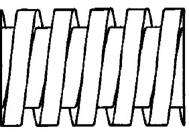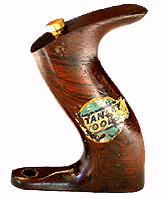

| B casting |
Stanley used many different foundry / casting marks, the most famous ones are B and S. Those marks were used by sub-contracting foundries. If you follow Smith, S castings were used between 1893 and 1899 , replaced by B castings 1899-1902. For bench planes the often quoted early B casting really should be replaced by early S casting followed by a short period of B castings. However, this might be the case for bench planes, special purpose planes and block planes didn't follow the same pattern. A great compromise is this one, found on the throat plate of an adjustable block plane: |
|
|
|
| Bailey, Leonard |
The most notable contributor to the success of the Stanley plane was the gifted tool maker Leonard Bailey. His 1867 patents for plane improvements are widely credited as the birth of all Stanley type planes. Of course there were others but history tends to forget the ones that ran third or fourth. Stanley bought Bailey's patent for the adjusters etc, so their planes looked similar. But they were made by Stanley. It was not an easy transition, they went to court over several issues. Long after the dust had settled and the matter was forgotten Stanley decided to honour the original inventor (after his death in 1906 I believe) by using the Bailey name on their bench planes. From then on they carried the imprint Bailey on the front and a lot of people called them Stanley-Bailey planes but Bailey was long gone, they all were and are 100% pure Stanley. |
| Bed Rock | Planes with "improved" frog.... see Stanley Bedrock |
|
|
|
| Corrugated | The “C” after the model number indicates a plane with a corrugated sole. The grooves are meant to reduce friction on sticky woods. C models are quite scarce in Australia and sell for up to 50% more than the normal flat soled planes. Beware of custom made grooves in the more valuable planes. Grooves should be even and look factory made |
Defiance Planes |
 Defiance Planes: The Bailey Tool Co was founded by Selden Bailey in 1872 in Woonsocket, Rhode Island. Selden was not related to Leonard Bailey but they did work together for a short time prior to the Stanley 1880 takeover. Some of the Bailey Tool Co Defiance planes have the company name embossed on the lever cap. |
| Fakes and repros | some samples here |
|
|
|
| Four-Square planes |
 Earlier budget line of tools started in the 1920s. Only a few planes are in this line including the household jack - see 5 ¼ . Valued at the lower end of comparable main line planes |
| Frog | Bench Plane Parts also see Orange frog further down |
Gage Planes |
The Gage Tool Company was established by John Porcius
Gage in 1883. John Gage secured Pat April 13, 1886 for a new adjustment
mechanism. Gage resisted Stanley’s advances for 30 years but after a
change in management in 1917 the resolve waned and in 1919 the Gage Co
sold out to Stanley. Early planes are marked Gage only, later types will
have the Stanley name on the middle strap of the cutter assembly and the
G prefix after the model number. |
| Grading Tools |
With the ever increasing popularity of buying tools without inspection i.e. absentee bidding, the need for a reliable grading system was obvious. Clarence Blanchard of the Fine Tool Journal came up with a solution that seems to be universally accepted. It grades tools according to condition from P (poor) Fr (fair) G- (good minus) G (good) G+ (good plus) and F (fine). The letters stand for a fairly complex definitions like: is the tool useable, has it been repaired, how much of the original finish is intact and so on...? One of those put-it-in-that-drawer-things a guy with a beard and glasses inevitably will come up with. It's a great system but it doesn't really work to compare tools from different sellers. All one seller can do is use the grading as comparative means to let you know the variances in the condition of his tools. The next seller might have far less experience and use altogether different standards. |
| Gunmetal | Often confused with gleaming steel, especially in English infill planes. Understandable if you think about Winchester rifle barrels. Think further back to those bronze cannons. That's gunmetal, an alloy of copper, tin and zinc. Used in some Stanley planes, all of them rare and expensive! |
| Handyman planes |

late budget line of planes. |
| Handy y feature | Name given to finger grips i.e. indents in squares or bevels, sometimes used for the finger grips on the sides of block planes as well. |
| History, Stanley | a short history of the Stanley Works and Stanley Rule and Level Company see here |
| IOB |
IOB in original box. If the box is as good as the plane it can easily double the price. I have found that a lot of dealers and collectors think the box automatically increases the value of the tool - regardless of condition. This might be true for the rarer models - for all others it's better to buy a good plane without box than an average plane in a box |
| Japanning |
Obviously originates from Japan and describes a glossy, highly polished finish derived from natural resins, usually with a black background, found on many Japanese objects. Became fashionable in Europe late1800s/early 1900s with a "modern" concoction of gum shellac, linseed oil and a few toxic nasties like red lead. A more recent version includes the use of linseed oil and asphaltum, still used to preserve etched plates but with more warnings on the label than your child's teddy bear. When you read: fatal when swallowed on a bottle you have to be really keen to brew up a new coat for your Stanley jointer! Some tool guys swear by the use of linseed oil repeatedly burned into the plane then polished. Why bother, there are perfectly good paints available in cans. I assume it's the constantly poor results of these re-japanning attempts that keeps the alchemists trying. I don't mind re-painted tools. A paint job might interfere with the sensitivities of many collectors but never slowed down a jointer in the hands of a craftsman. Finish on planes is often estimated in percentage points. Anything over 90% adds to the price. |
| Junior planes | refers to technical school planes, sizes 5 1/4 and 203 |
| Knuckle-joint | The knuckle joint lever cap provides a nice, smooth grip without the hard edges of the 9 1/2 series block planes. The simple design of the early types doesn't work - if you like a knuckle joint cap go for the later models. see block plane 18 |
| Nickel Plating |
Stanley used nickel plating on many of their tools. During WW2 the use of nickel was restricted as nickel was appropriated for the war effort. During this period Stanley used japanning on parts that traditionally were nickel plated. Replating is not easy because the electroplating process requires at least a basic electrolysis set-up. I was told that dry nickel plating i.e. without electrolysis is available. Some of the commercial outfits that chrome plate car parts handle nickel as well and they might replate your plane for a relatively small fee. If you want to go down that path make sure you don't plate any screws, screw threads or any other opening for depth stops, rods etc. Re-plated parts won't fit any more. If the plating is flaky, rusty and ugly remove it all and polish the tool. It will look almost as good as plated. |
| Nickel plated trimmings | In Stanley jargon nickel plated trimmings include lever cap, (depth) adjuster nut and front knob. |
| Nicker | Term used for any kind of spur on a plane. Used to "nick" the surface of the wood i.e. pre-cut or scribe the wood resulting in a clean cut by the main cutter. |
| Orange frog | orange sides on frogs are original and
only found in late model SW vintage planes including Bedrocks.
Reportedly used in batches for a large N.Y. hardware company but they
seem to surface worldwide. I rate them as scarce.
|
| Parts sources |
 |
| Prototype | Chances that you come across one are virtually nil. Don't fall for the "prototype" sales pitch to explain missing bits, missing markings or any foreign objects on a Stanley tool. By all means, take a punt but never pay top dollar for any tools sold as prototype. It's usually the prototype of all cons. |
| Rabbet, Rebate | Synonyms. Rabbet is the older form. Stanley USA used rabbet (plane) up to around WW2. Later and UK models are usually rebate (planes) Most probably a bastardised French word. |
| Reproductions | some samples here |
| Rosewood | The majority of Stanley planes were fitted with rosewood handles and/or knobs. Like any other natural product, rosewood comes in many different colour shadings. Typically red or dark brown with black streaks running through the grain. Sometimes the streaks form attractive patterns. Variegated rosewood with light and dark patches is also very attractive. If I remember correctly Cuban and Indian rosewood was used by Stanley. Some "modern" Brazilian rosewoods are good matches but hard to find because of import bans. |
| Salesman's samples | A nasty virus developed by antique dealers and spread over the internet, labels everything under 6 inches as salesman's sample and worth a mint! Salesman's samples do exist but usually are in the form of display units etc. No, the Stanley # 1 was not manufactured as a salesman's sample but it's quite likely that a Stanley salesman could have carried one with him. |
| S casting | see under B casting |
| Screw threads | see parts sources |
| Spur |
See nicker |
|
|
|
| SW Sweetheart
|
 SW stands for Stanley Works but is commonly known as Sweetheart because of the heart shape in the logo. The logo is found punched into cutters, usually accompanied by a decal (sticker) on the handle or the plane body from around 1921 to 1935. SW vintage tools are widely regarded as the most collectable Stanley vintage tools. Decals: watch out for fakes, they are for sale on eBay. |
| Transitional planes | Planes with a beech wood body and metal upper parts. Few examples were made with rosewood soles as special edition/presentation planes. The name implies a transition between early wooden planes and later metal planes. I don't know why this came about. If I'm not mistaken Bailey produced the metal plane well before the transitional planes hit the sales catalogues! Must be one of those afterthoughts plane historians came up with. |
|
Two-Tone Planes
|
These planes were produced as an advertising gimmick
for the National Hardware Conventions in 1940/41 and again in 1950/51. |
|
|
|
| Victor planes
|
Victor (see Bailey) planes have distinctive large knobs embossed with the Victor name. They are often missing and devalue a plane by a lot. Same goes for the two-part front knob. Handles are cast iron. |
|
|
|
| Victor plane, late
|
Stanley resurrected the name for a budget line of planes from 1935-1942. They are user tools and have very little value to collectors. Not to be confused with the Bailey Victor planes! Gray coloured plane beds with red back irons. |